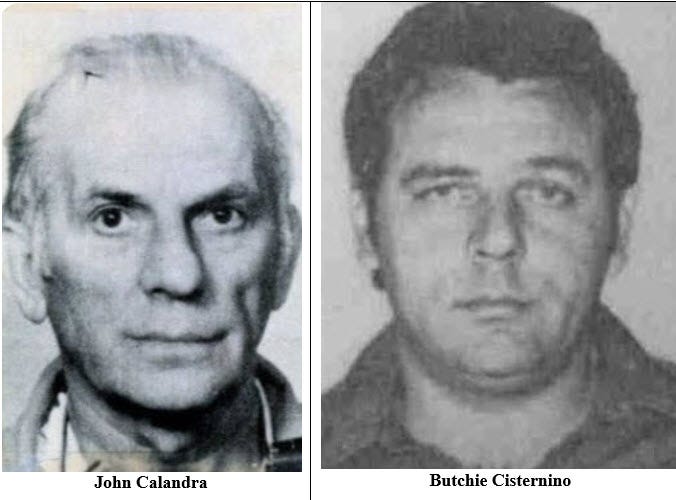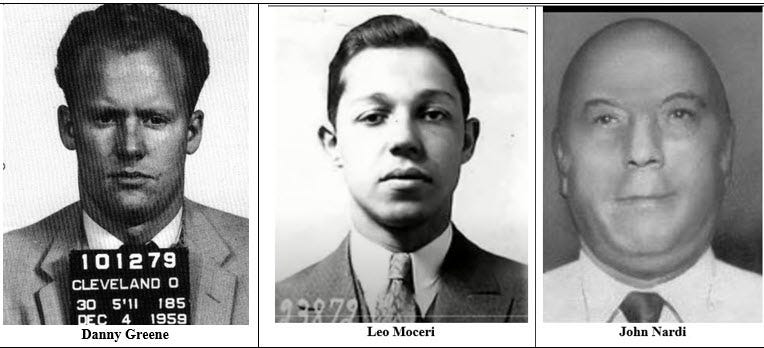After I completed but before the release of my second book, The Hunting of Cain (1983), a true story about a contract killing in Bath, Ohio, I began looking for another book project. Then, after reading a fascinating series of articles in Cleveland Magazine about the Cleveland Mafia, I contacted the author, the legendary Ned Whelan, who was well-known and respected for his true-crime work.
Ned and I agreed to consider co-authoring a book about the life and the 1977 killing of Danny Greene, the boss of the Irish Mafia in Cleveland. Our working title was Ashes to Ashes.
We agreed to focus our basic plot on the two U.S. Strike Force attorneys who prosecuted the murder case, Abe Poretz and John Sopko, both of whom I had interviewed at length. (Notably, Sopko was and still is a close friend of mine.)
On March 25, 1983, Ned and I delivered our proposal to my literary agent, Philip Spitzer, who pitched it to a handful of publishing houses in New York. Unfortunately, we did not receive what we considered a legitimate offer. Consequently, we dropped the project, shook hands, and went our separate ways.
In 1998, author Rick Porrello published an outstanding book about the rise and fall of Danny Greene, To Kill the Irishman: The War That Crippled the Mafia (Next Hat Press). Rick’s remarkable work, which did not deal with the prosecution of Greene’s killers, was later adapted as an action-packed 2011 motion picture.
Here is how Ned, who sadly passed away in 2013, and I opened our proposed project.
* Part 1: “Consequences after the death of mob boss John Scalish,” June 8, 2025.
* Part 2: “James Licavoli succeeds John Scalish as the local crime boss,” June 15, 2025.
* Part 3: “A comedy of errors foils an impromptu attempt to kill Greene and Nardi,” June 17, 2025.
Here is Part 4: “Penetrating Greene’s world”
The day before local Mafia boss Tony Delsanter's funeral in Warren, Ohio, in August 1977, Ray Ferritto met with Cleveland’s new Mafia boss James Licavoli and Jimmy Fratianno. During their conversation, Licavoli announced that he had "a broad," who was working for the FBI, feeding them information.
Licavoli pulled the list of informants from his pocket and showed it to Fratianno, who was aghast when he saw it. One of Fratianno's long-time Mafia associates in southern California, Frank Bompensiero of San Diego, was on it.
"Bomp," who was murdered in February 1977, had apparently been feeding information to the FBI about his meetings with Chicago underworld boss Joey Aiuppa.
Licavoli said he was going to send the informants' list to Aiuppa and other crime family bosses to see whether they recognized any other names.
The day after Delsanter’s funeral, Ferritto and Licavoli met for dinner at Sabatini's restaurant in Warren. Licavoli told Ferritto to see John Calandra, who was also present at the meeting, if he wanted anything. Ferritto repeated that he needed a new car and an apartment.
Licavoli also confided that he was planning to have Greene's phone wiretapped so that they could collect more information about his movements.
Further, Licavoli announced that—with Delsanter now dead—Ron Carabbia would assume control of his territory in Warren. He told Ferritto that after Greene's murder, he planned to take him to Detroit to become a "made" member of the Mafia. As a result, Licavoli concluded, Ferritto would work with Carabbia and receive 25% of the gambling and loan-sharking action in Warren and Youngstown.
Pleased with Licavoli's promises, Ferritto drove from Warren to Cleveland three days later and met with Carabbia, who gave him $5,000 for expenses. Ferritto also stopped by the motel room shared by Butchie Cisternino and Allie Calabrese. He noticed a gun on one table and a police scanner on another.
In early August, FBI employee Geraldine Linhart returned to the bureau’s informants' room. Again, nobody was there. She took a few three-by-five index cards from a file cabinet. On the cards were the names of fifty-six FBI informants. She copied down both the names and codes of all the informants.
She then called Ken Ciarcia and told him what she had. He asked her to come to his home after work. When she arrived alone, he took the list and read it, saying that he didn't know very many people mentioned. He wondered out loud whether the FBI used false names for their informants.
Geraldine assured him that these were the informants' real names.
Ciarcia also asked if any of the people on the list were paid informants. Geraldine said that all of them were paid one way or another.
At the conclusion of their conversation, Geraldine again said that she was frightened by what she was doing and asked him not to request any more information. Ciarcia replied that her services were no longer necessary.
In mid-August, Cisternino gave Ferritto two cassette tapes during their meeting in Cleveland. But, when Ferritto played the tapes—which were recordings from Greene's telephone—they were unintelligible. The voices were garbled and sounded like a Mickey Mouse cartoon. Cisternino said he would have the problem fixed.
Immediately upon his return home, Ferritto received a call from Carabbia, who asked him to come to Youngstown. During their meeting later that day, Calandra and Cisternino walked into Carabbia’s house with the same two tapes Ferritto had heard earlier. The problem was that the tapes had been recorded at a higher speed.
Although the information on the tapes was interesting, it was dated and of virtually no use to Ferritto. Still, the tapes proved that Greene was making calls to the Cleveland FBI office, using the code name "Mr. Patrick."
While the coconspirators listened to the tapes, they discussed their strategy to kill Greene. Ferritto and the others were told by Calandra that Anthony Liberatore was going to try to set up Greene for the hit.
Ferritto returned to Erie and continued to receive Greene's tape-recorded conversations from Calandra and Cisternino. However, as with the first set, all the information was too outdated.
With complete frustration, Ferritto again complained about the Cleveland Mafia’s bush-league operation.
Simultaneously, former Greene associate Tony Aratari quietly began working for Tom Lanci, Liberatore's right-hand man. In August, Lanci asked Aratari to kill Greene. Lanci arranged a meeting between Liberatore and Aratari, at which time Aratari was formally offered and accepted the contract. He was to receive $5,000 for the job.
Aratari told Liberatore that he planned to split the money with his partner, Vic Guiles, a trained sniper. Later, Calandra picked up Aratari and, along with Liberatore, drove past Greene's apartment building on Lakeshore Boulevard. While cruising by, Liberatore ducked down in the back seat.
In Erie, Ferritto remained disillusioned. By late August, he had still not received a better car or his Cleveland apartment. In addition, all the information he was receiving continued to be cold coffee.
But on August 30, Ferritto was called back to Cleveland to meet with Calandra, Carabbia, and Cisternino. Ferritto checked into the Ramada Inn on Euclid Avenue under his own name. He paid for the room, as always, with his own credit card.
That same night, Aratari and Guiles ran into Liberatore at the Roman Garden restaurant. During their discussion, Liberatore was asked by Aratari who James Licavoli was. Liberatore replied, "He's the number-one man," and then boasted, "I'm second in command."
In fact, Angelo Lonardo was still Licavoli's underboss.
Liberatore also told Aratari and Guiles that "two other family people" had been contracted to kill Greene, and he wanted all of them to get together. Liberatore instructed Aratari to be near his phone the following day and to wait for further instructions.
Aratari and Guiles had been stalking Greene for a couple of weeks. After initially accepting the contract and receiving a .22 automatic, equipped with a silencer from Lanci, the two men followed Greene to one of his favorite restaurants, The Flame.
By chance, Aratari was spotted by Bill Peterson, one of Greene's thugs, and a shoving match ensued. Ironically, Greene later chided Peterson for being so rough with Aratari, whom Greene assumed was still loyal.
Although Greene mistakenly continued to believe that Aratari was an ally, Kevin McTaggart and Keith Ritson, like Peterson, did not. Greene's two bodyguards physically threw Aratari out of the bar at the Lithuanian Club on Cleveland's east side. A day later, McTaggart and Ritson chased Aratari and Guiles down the street in their car after they caught them circling the block around Greene's trailer.
On August 31, Calandra, Carabbia, Cisternino, and Ferritto met in Ferritto's room at the Ramada Inn. Calandra—who had brought along Licavoli's white poodle—mentioned that there were two men working for Liberatore who thought that they, too, could get to Greene. Ferritto argued that there were too many people involved, adding that he never trusted Liberatore.
Calandra told Ferritto not to worry, because "he's one of us." Upon Calandra's insistence, Ferritto agreed to meet with Liberatore's men.
Calandra got up from his chair, walked to the telephone, and made a call. An hour later, Aratari appeared at the motel room.
After Aratari was introduced to everyone in the room, he gave a long report about Greene and his habits, mentioning that Greene had a hidden second telephone in his apartment.
Ferritto interrupted and suggested that a tap be placed on Greene's second phone. The others agreed.
Carabbia and Ferritto contacted a mutual friend, Tom Sinito, an electronics surveillance expert and a top lieutenant to Angelo Lonardo, Licavoli’s underboss. Working with Sinito, Carabbia managed to get the key to the main telephone box in Greene's apartment building.
Ferritto rented a room on the sixth floor of the building, three floors above Greene, where the surveillance equipment would be set up and calls from Greene's second, private phone could be wiretapped. The mechanism was automatically activated when Greene's phone rang.
During this surveillance, Ferritto learned that Greene's girlfriend, Denise Schmidt, was arranging a party for her man on September 6 at The Flame. On that day, Ferritto and Carabbia drove to the restaurant, hoping to kill Greene going in or coming out of the restaurant.
However, their plans fell apart when they saw Greene's son and McTaggart standing by Greene's car. Because both looked like they were expecting trouble, Ferritto and Carabbia decided not to proceed with an attempt on Greene.
In early September, Ferritto and Carabbia decided to place an unmarked box at the entrance of Greene's apartment building. The box was planted in the bushes about ten feet from the door. They had planned to put a plastic bottle—filled with screws, nails, and gasoline, which could be detonated—in the box.
Then, as Ferritto, who planted the box, walked away from the building, he changed his mind and decided to remove the bomb.
Too many innocent people could get hurt, which would bring closer scrutiny and severe retribution against the local Mafia by the law-enforcement community, the public, and the press.
On September 24, a court-authorized FBI wiretap recorded a conversation between Licavoli and one of his associates. They were discussing Danny Greene.
Licavoli: This fuckin' Irishman. . . . He's gotta make a mistake. He's gotta go.







